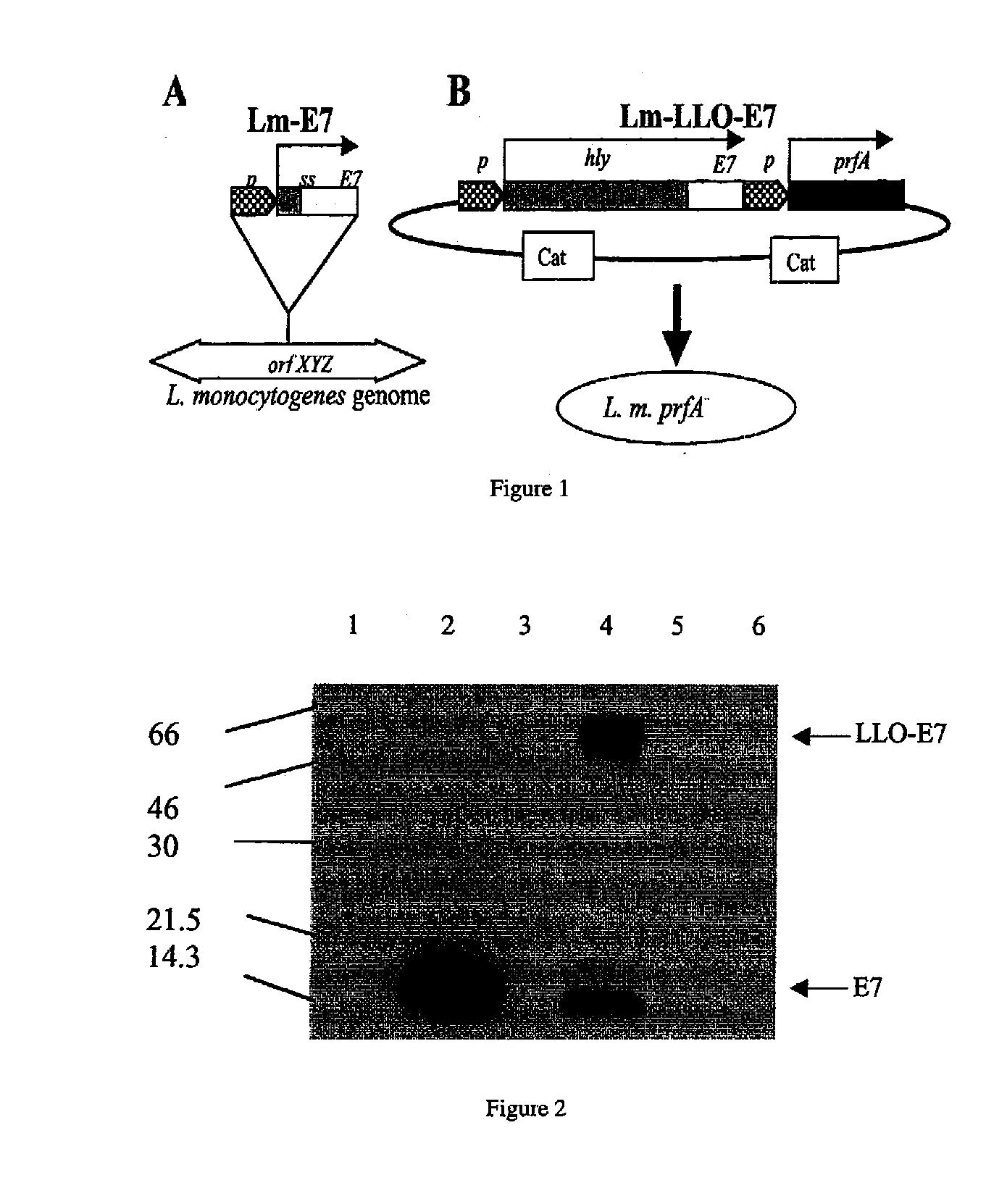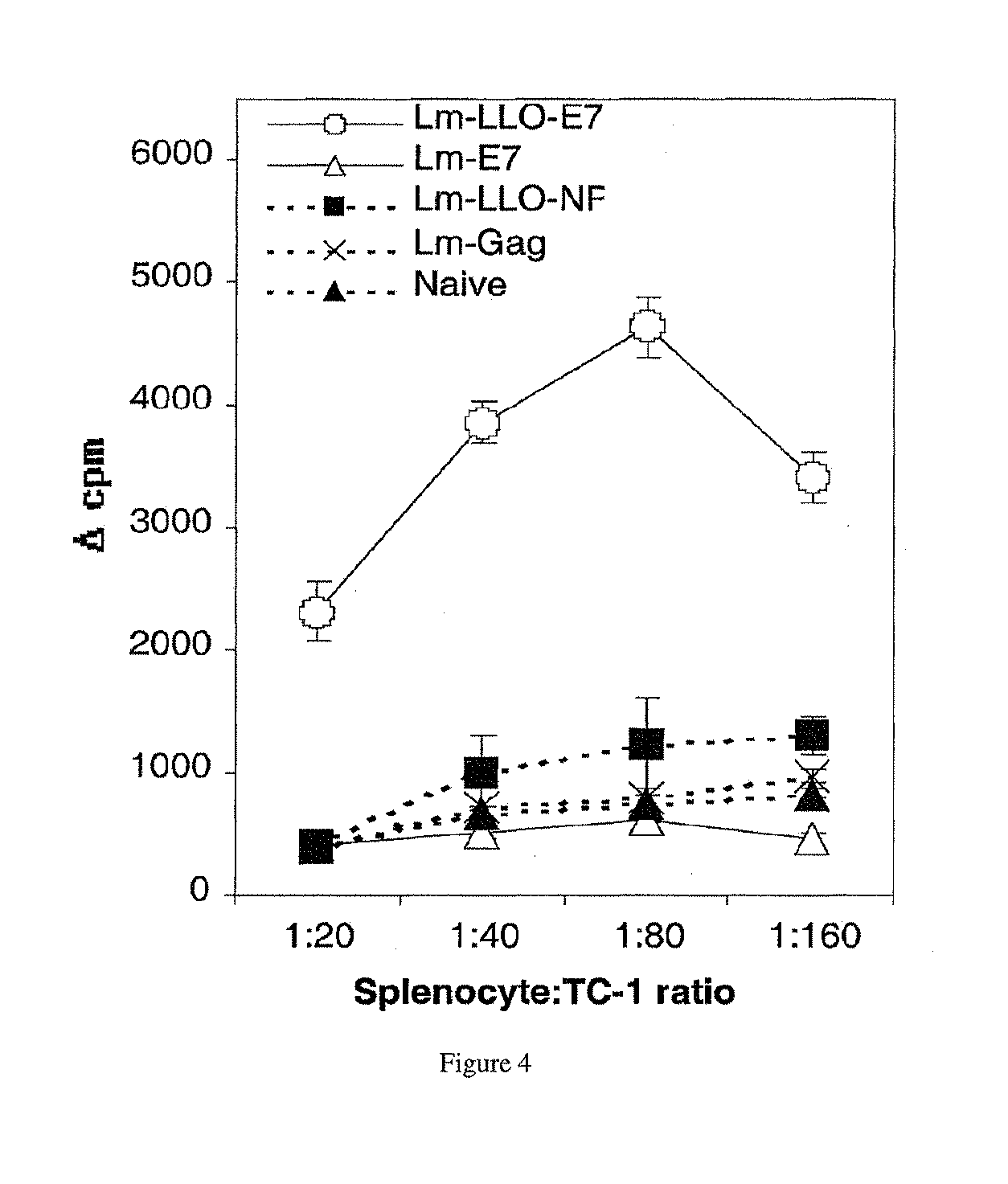Suppressor cell function inhibition following listeria vaccine treatment
a listeria vaccine and suppressor cell technology, applied in the field of suppressor cell function inhibition following listeria vaccine treatment, can solve the problems of increased disease and poor prognosis of /sup> tregs, and achieve the effect of increasing the ratio of t infiltrating lymphocytes to suppressor cells
- Summary
- Abstract
- Description
- Claims
- Application Information
AI Technical Summary
Benefits of technology
Problems solved by technology
Method used
Image
Examples
example 1
LLO-Antigen Fusions Induce Anti-Tumor Immunity
Materials and Experimental Methods (Examples 1-2)
Cell Lines
[0230]The C57BL / 6 syngeneic TC-1 tumor was immortalized with HPV-16 E6 and E7 and transformed with the c-Ha-ras oncogene. TC-1, provided by T. C. Wu (Johns Hopkins University School of Medicine, Baltimore, Md.) is a highly tumorigenic lung epithelial cell expressing low levels of with HPV-16 E6 and E7 and transformed with the c-Ha-ras oncogene. TC-1 was grown in RPMI 1640, 10% FCS, 2 mM L-glutamine, 100 U / ml penicillin, 100 μg / ml streptomycin, 100 μM nonessential amino acids, 1 mM sodium pyruvate, 50 micromolar (mcM) 2-ME, 400 microgram (mcg) / ml G418, and 10% National Collection Type Culture-109 medium at 37° with 10% CO2. C3 is a mouse embryo cell from C57BL / 6 mice immortalized with the complete genome of HPV 16 and transformed with pEJ-ras. EL-4 / E7 is the thymoma EL-4 retrovirally transduced with E7.
L. monocytogenes Strains and Propagation
[0231]Listeria strains used were Lm-LLO...
example 2
Lm-LLO-E7 Treatment Elicits TC-1 Specific Splenocyte Proliferation
[0243]To measure induction of T cells by Lm-E7 with Lm-LLO-E7, E7-specific proliferative responses, a measure of antigen-specific immunocompetence, were measured in immunized mice. Splenocytes from Lm-LLO-E7-immunized mice proliferated when exposed to irradiated TC-1 cells as a source of E7, at splenocyte: TC-1 ratios of 20:1, 40:1, 80:1, and 160:1 (FIG. 4). Conversely, splenocytes from Lm-E7 and rLm control-immunized mice exhibited only background levels of proliferation.
example 3
ActA-E7 and PEST-E7 Fusions Confer Anti-Tumor Immunity
Materials and Experimental Methods
Construction of Lm-ActA-E7
[0244]Lm-ActA-E7 is a recombinant strain of LM, comprising a plasmid that expresses the E7 protein fused to a truncated version of the actA protein. Lm-actA-E7 was generated by introducing a plasmid vector pDD-1, constructed by modifying pDP-2028, into Listeria. pDD-1 comprises an expression cassette expressing a copy of the 310 bp hly promoter and the hly signal sequence (ss), which drives the expression and secretion of ActA-E7; 1170 bp of the actA gene that comprises four PEST sequences (SEQ ID NO: 11) (the truncated ActA polypeptide consists of the first 390 AA of the molecule, SEQ ID NO: 10); the 300 bp HPV E7 gene; the 1019 bp prfA gene (controls expression of the virulence genes); and the CAT gene (chloramphenicol resistance gene) for selection of transformed bacteria clones (Sewell et al. (2004), Arch. Otolaryngol. Head Neck Surg., 130: 92-97).
[0245]The hly promo...
PUM
| Property | Measurement | Unit |
|---|---|---|
| resistance | aaaaa | aaaaa |
| densities | aaaaa | aaaaa |
| color | aaaaa | aaaaa |
Abstract
Description
Claims
Application Information
 Login to View More
Login to View More - R&D Engineer
- R&D Manager
- IP Professional
- Industry Leading Data Capabilities
- Powerful AI technology
- Patent DNA Extraction
Browse by: Latest US Patents, China's latest patents, Technical Efficacy Thesaurus, Application Domain, Technology Topic, Popular Technical Reports.
© 2024 PatSnap. All rights reserved.Legal|Privacy policy|Modern Slavery Act Transparency Statement|Sitemap|About US| Contact US: help@patsnap.com










